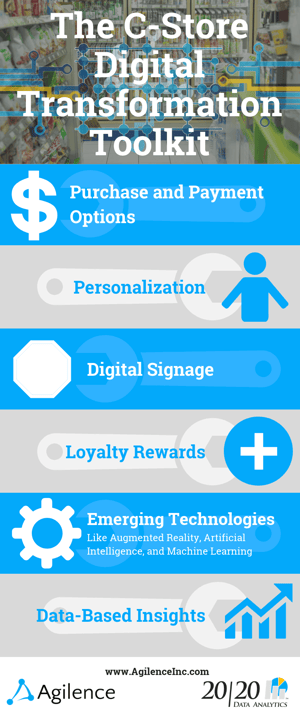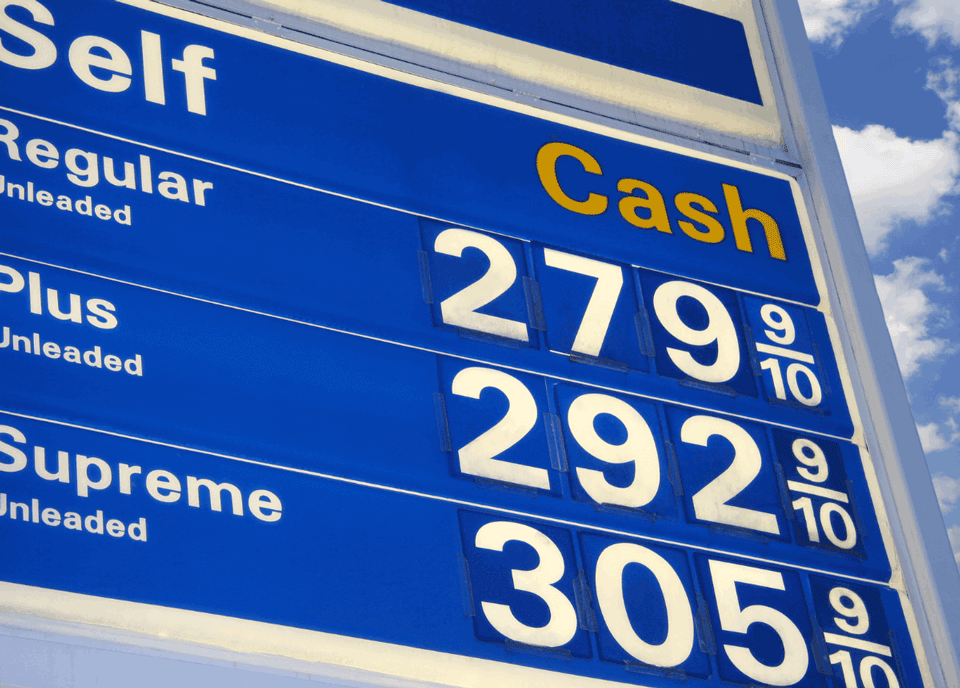The Role of Data in the Digital Transformation of C-Stores
Retail Pedro Ramos
Pedro Ramos

Consistent technological advancements have disrupted nearly every industry. Within just a few years, the term digital transformation has evolved from a non-descript buzzword to a necessary business-wide strategy. With the increasing number of disruptors in the convenience space, C-Stores will need to consistently adopt emerging technologies and holistic digital strategies to hold onto and grow their customer bases.
Digital Transformation and Disruptive Innovation
At its highest level, digital transformation is defined as integrating digital technologies into all areas of a business to create or react to business innovations that disrupt existing industries or create new ones. It requires a fundamental change to how businesses operate and deliver value to customers, but also demands that organizations nurture an internal culture of change as technologies continue to develop at exponential rates.
A few of the most common examples of digital disruptions are Netflix, Uber, and iTunes. All three of these utilized digital technologies to fundamentally change impacted industries in radical and permanent ways. The impact of Netflix on Blockbuster, in particular, offers a cautionary tale of what can happen when an organization fails to react to industry-wide digital disruptions.
Like these industries, retail has and will continue to be disrupted by digital technologies. Nearly every step of the shopper’s journey has been or is being digitized. The C-Store in particular is being disrupted by Amazon’s new cashierless prototype Amazon Go, Reebok’s reimagining of gas stations into fitness and wellness centers in the wake of electric and autonomous vehicles, and the continued expansion of direct-to-consumer delivery.
Unlike the greater retail industry, C-Stores haven’t yet seen the full impact of the greater societal shift to digital. In fact, US convenience stores reported record in-store sales in 2017, likely driven by the consumer’s desire to satisfy immediate needs. Which makes sense, as 83% of in-store products were consumed within one hour of purchase and 65% were immediately consumed after purchase. The top 10 in-store product categories all saw positive sales from 2016 to 2017 with tobacco products (34.1% of in-store sales), food service (22.5% of in-store sales), and packaged beverages (15.8% of in-store sales) leading the way.
However, convenience is at the center of the digital customer experience, and it’s only a matter of time until industry disruptors find a way to satisfy immediate needs. C-Stores must make an already near seamless user experience – the average transaction taking only about two minutes – even more frictionless through data-backed digital transformation strategies.
Becoming a C-Store of the Future
In order to become a C-store of the future, organizations must increasingly adopt customer-centric, omnichannel strategies, in which digital channels become another platform on which to communicate and connect with customers both inside and outside the store. Utilizing available digital technologies that engage today’s consumers, while fully meeting customer expectations should be the ultimate objective of c-store digital transformations.
Digitize Convenience for the Digital Consumer
C-Stores have traditionally described their average consumers to be mid-30’s, male, and blue collar. Often nicknamed “Bubba” by industry professionals, this consumer typically thrives on cigarettes, coffee, soda, and hot dogs and is motivated by hearty foods that can satisfy hunger at a low cost. The stats above prove that this is still at least somewhat true as tobacco products and food service still dominate in-store purchases. However, demographics are changing, at least partially because of digital technologies, and if C-Stores are still exclusively catering to Bubba, they’re in danger of being left behind.
Today’s Bubba may still be young, male, and lower income. However, he is likely also well-educated, health conscious, and tech savvy. He is focused on hearty, protein packed snacks that can be consumed quickly on the go. Now referred to as the Functional Eater, this persona now represents the most common foodservice consumer archetypes.
The second most common foodservice consumer archetype is the Balanced Eater. The female counterpart to the Functional Eater, the Balanced Eater is young, with middle-to-upper income who visits C-Stores to buy foods, especially breakfast and beverages, that are healthy, crave-able, and can be consumed on the go.
Catering to the new demographics of regular C-Store shoppers is the key to continued success. As demographics continue to evolve and become more technology driven, connected, and digital, C-Stores must also evolve and adopt digital technologies.
Digital Transformation is a Business Transformation Executed with Digital Tools
Digital technologies are simply the tools that power a true business-wide transformation. The same way that you can use many different tools to build a bookcase, you can use many different digital technologies to power a digital transformation.
 Purchase and Payment Options
Purchase and Payment Options
For most digital-savvy consumers, true convenience is being able to purchase what they want, when they want, how they want. This means that C-Stores will need to continue to expand the purchasing options available to their customers. Some stores have already adopted mobile payments, in-store kiosks, and/or in-advance ordering with pickup or delivery options. Mobile apps are also becoming more and more popular because they provide increased convenience for both customers and store operators. Mobile apps also offer the opportunity to integrate payment systems with current promotions, loyalty and rewards programs, store location, hours of operation information, and even nutritional information all in one convenient location.
Personalization
Data-based insights into customer behaviors give C-Stores the opportunity to create an improved customer experience, but it also presents the store with the ability to increase the size of sales by automating and optimizing the upsell and cross-sell process. For example, when a customer orders a sandwich on a touchscreen kiosk or from the store’s mobile app, customized recommendations based on commonly ordered pairings or even better, that customer’s specific buying history, can be made.
Digital Signage
Speaking of upselling and cross-selling, digital signage is another way to utilize modern technology to facilitate these selling opportunities. For example, LED lights at the gas pump promoting products to lure customers inside, or in-store signs that promote breakfast sandwiches in the morning and seamlessly switch to snacks or lunch sandwiches during lunch hours. Digital signage presents a cleaner, more modern replacement for the static posters, flyers, and cardboard displays that have traditionally cluttered the C-Store.
Loyalty Rewards
It should come as no surprise that as many as 44% of customers choose a convenience store based on location. However, a recent report found that 43% visit a convenience store because it offers a loyalty program. Evolving technology has presented C-Stores with the opportunity to deliver varying levels of rewards based on guest visit, spending, and purchase behavior. Data insights collected from customer loyalty programs (often requiring the customer’s permission) can lead to a win-win for both consumers and retailers. With detailed information about buying habits and preferences, retailers can create personalized incentives that reward certain behaviors to maximize their return on promotional investments.
And more Emerging Technologies
As technology continues to develop, the possibilities are endless for new ways that C-Stores can continue to improve upon the customer experience. Retailers have already begun experimenting with Augmented Reality (AR), Artificial Intelligence (AI), and Machine Learning. Stores that want to improve their competitive positions should do more than play catch up and look to the latest advances in technology to build or adopt systems that are innovative and long-lasting.
Rely on Data-Driven Insights
As stated earlier, the use of digital technologies to engage consumers, while meeting customer expectations should be the ultimate objective of c-store digital transformations. This is only possible through the use of organization-wide data to deliver actionable insights. Disruptors like Amazon are leveraging data to generate loyalty and unparalleled digital convenience. As they delve into the world of C-Stores with their new Amazon Go stores, other C-Stores will need to leverage their data in the same ways.
Technology for technology’s sake is meaningless but by relying on data analytics, you’ll know which technologies are right for your organization. Convenience retailers need to focus on the digital value chain – one focused on collecting data about products, customers, and locations and turning that data into insights using robust business intelligence and data analytics tools. Only then can those insights be turned into actions.
Related Articles

Are Overlapping Categories Reinventing the Convenience Model?
Whether chasing core categories like tobacco and alcohol or streamlining the customer experience by eliminating the checkout ...
CBD in Convenience Stores: How Cannabis Products are Transforming C-Stores
For a natural remedy cultivated to combat anxiety, the cannabidiol (CBD) industry hasn’t been causing much calm for convenien...
How Convenience Stores Can Increase Pump-to-Store Conversions
The average gas station attracts about 300 customers a day, but only 35% of those customers ever set foot inside the store. T...Subscribe to our blog
Receive free educational resources like exclusive reports, webinars, and industry thought leadership articles straight to your inbox.

